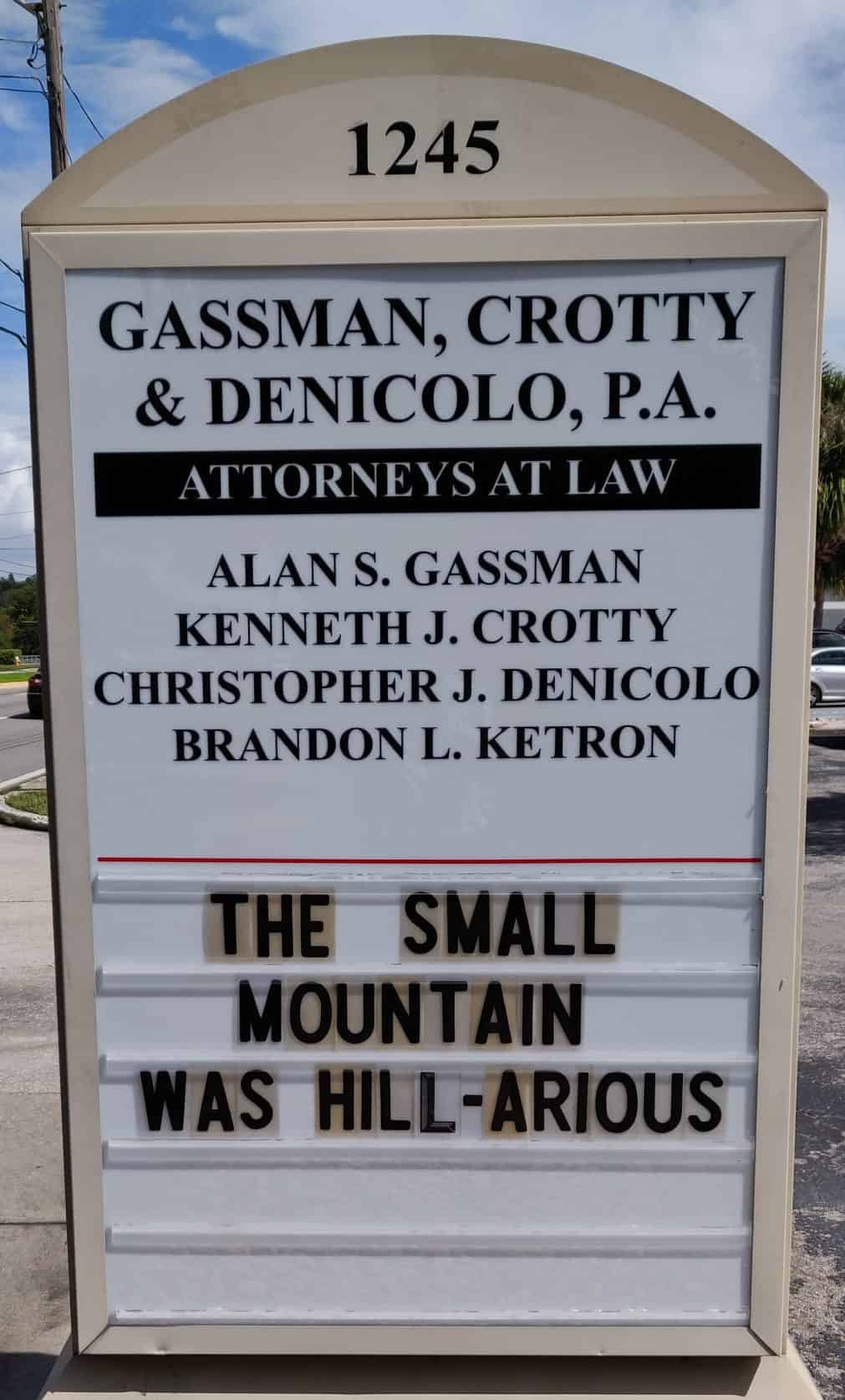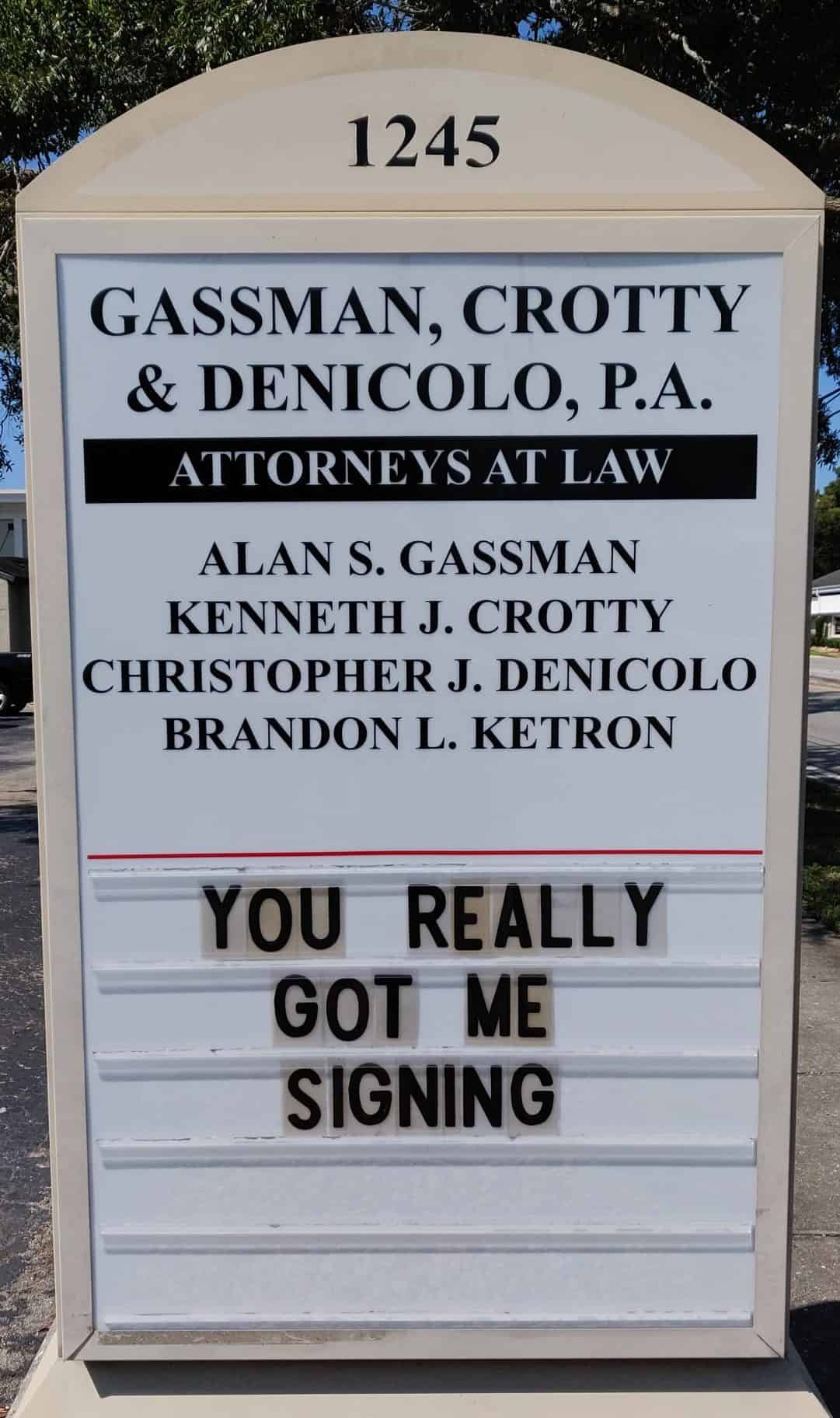Thursday Report – Issue 290


ALWAYS FREE, SOMETIMES PUBLISHED ON THURSDAYS
Thursday, October 15, 2020 – Issue 290
Having trouble viewing this? Use this link
Entity Transfer, Gift & Income Tax Planning for PPP Borrowers – New Challenges Call for Old Solutions
Upcoming Events
New PPP Application 3508S For Many But Not All
Don’t Be A Notary Blockhead – Part 1
For Finkel’s Followers
Humor
Entity Transfer, Gift & Income Tax Planning for PPP Borrowers – New Challenges Call for Old Solutions
Alan Gassman, Brandon Ketron, Katherine Funk & Kevin Cameron




EXECUTIVE SUMMARY:
SBA Procedural Notice 5000-20057 which was issued last week has given estate and tax planners great pause with reference to if and when a transfer of entity assets or entity ownership can be made for an entity that has a PPP Loan. This applies even if the entity has spent all of its PPP loan monies on permitted expenses that entitle it to complete forgiveness.
All of this comes during the “perfect storm” of year-end planning for 2020, whereby a great many taxpayers are in the process of transferring significant value to make the maximum use of what remains of their
$11,580,000 estate and gift tax exemptions, given that the exemption amount may be reduced significantly in 2021, if there is a regime change in Washington D.C.
COMMENT:
Kevin Cameron CPA has had recent experiences with PPP borrowers who have sold their businesses without approval. Each lender has different loan documents for PPP loans and many of them prevent asset sales without lender approval. Other lenders have loan documents that do not call for lender approval. Borrowers tend to think that they do not need approval if it is clear that the loan situation qualifies for forgiveness, but the SBA apparently disagrees with this. In general, the lenders that Kevin has worked with have been cooperative to allow the transfers and have indicated that they are communicating with the SBA to receive approval. In one situation, a borrower sold the entire business and expects complete forgiveness. The borrower put the lender on notice that they were declaring the end of their Covered Period two days before the sale. The lender indicated that the sale of assets should not be an issue, but has requested that the borrower immediately submit their Forgiveness Application. In another situation the lender advised the borrower to take no further action until the lender consults with the SBA. Clearly, the SBA and lenders did not contemplate that a business asset or ownership change may have already occurred prior to the issuance of the Procedural Notice.
So, some lenders do not know how to handle these transactions. We know of no reason to expect that loan forgiveness will not occur if there has been a breach of the loan provisions, but there is no specific authority for this, and we now have this SBA pronouncement, which must mean that there may be a negative consequence of not complying with this new rule.
A number of planning options come to mind to be considered for borrowers in these circumstances:
Sell Some Assets (Or Ownership) and Give an Option to Buy the Rest.
When a borrower wants to sell its business without receiving SBA or lender approval it may consider instead selling up to 50% of business assets and giving the purchaser an option to purchase the other 50% based upon a reasonable option payment and a reasonable exercise price that is in substance an option and not considered to be an installment sale. This may be accomplished by setting the option price high enough so that there is a substantial risk that the option holder will not exercise the option and will lose the deposit, such as if the business will not recover when the COVID-19 virus pandemic has ended.
Use a License or Management Agreement
Another planning idea is to license the right to use and operate the business under a license or management agreement which gives the licensee the ability to derive a reasonable profit from operations and allows for an option to purchase the business which, as indicated above, should be structured in a way that does not make the arrangement appear to be an installment sale. This means that the option payment should not be so large as compared to the exercise price that it seems extremely likely that that option will be exercised. A valuation firm should be engaged, if possible, to determine what an appropriate option price, exercise period, and exercise price should be.
Under Internal Revenue Code (“IRC”) section 2703, in order for an option and its exercise price to be respected for estate and gift tax purposes the following requirements must be met:
- Must be a bona fide business arrangement
- Cannot be considered a device to transfer property to an owner’s family for less than full and adequate consideration
- Terms must be comparable to similar arrangements entered into by a person in an arm’s-length transaction
Common/ Preferred “Partnership Freezes”
For clients who have wanted to gift or sell a significant portion of ownership of a PPP borrower entity to a grantor trust or a family member, the former objective of selling a 99% non-voting member interest may be changed so that the taxpayer sells a 49% ownership interest, and retains a 51% interest so as not to trigger the SBA approval or escrow requirements.
In that event, it may be possible to recapitalize the entity into common and preferred interest like a “partnership freeze” assuming that the entity is not an S-Corporation. If the entity is an S-Corporation then the second class of stock rules will be violated by such an arrangement. But an S-Corporation may convey its assets into a subsidiary entity and another person or entity could convey other assets, such as another business to that subsidiary entity, which may be taxed as a partnership, and a common/preferred arrangement may be established between the two entities, although this can be complicated and partnership tax rules must be carefully reviewed.
A typical recapitalization will involve having an amount equal to 90% or less of the value of the entity be considered to be a preferred return interest that might, for example, be entitled to receive 6.5% minimum annual coupon rate.
Any growth in excess of 6.5% would inure to the common interest.
For example, if an entity is now valued at $10 million during the crisis but may bounce back to $15 million thereafter if things go as hoped, then a 49% common interest might be sold under an installment sale, and a 51% preferred interest can be valued at $5,100,000 with a 6.5% coupon rate. If this is to comply with IRC section 2701, then the coupon rate amount will need to be paid each year, and other requirements must be met.
If the entity springs back to a $15 million value the common ownership interest may be worth approximately $10 million, and the 51% preferred interest may remain valued at not much more than $5 million.
Triggering A Gift Without a Gift With a Non Qualifying Partnership Freeze—The Use It So I Won’t Lose It, But May Eat My Cake Too
Structuring must be handled very carefully with a preferred interest partnership/LLC arrangement. If the arrangement does not qualify under IRC section 2701 then any gift or transfer of the common interest may trigger a gift tax event based upon the entire value of the entity, even if the common interest transferred is 10% or less of the value of the entity.
This can be useful for taxpayers who are not certain whether they want to make an irrevocable gift in 2020 that would use their entire remaining estate tax exclusion, because the Section 2701 rules would allow the exemption used on gifting to be applied in a later year as a credit, even if the estate tax exemption is reduced.
For example, an individual with a $9 million estate and gift tax exemption remaining could put $10 million into an LLC that has borrowed PPP funds and recapitalize it into a 90% preferred interest that may be entitled to a 6.5% per year return, but the 6.5% may not be paid out annually, and may instead accrue to some extent. The common interest may be worth $1 million.
If the $1 million common interest is gifted to an irrevocable trust then the individual would be considered to have made a $9 million gift under IRC Section 2701, and if the preferred interest is still owned by the individual upon death then the individual’s estate tax exclusion allowable against the partnership interest can be as high as $9 million, even if the exclusion has been reduced by legislation or the 2026 reduction in half, based upon the IRC Section 2701 rules.
This planning technique was covered in LISI Estate Planning Newsletter #2827 by Stephen M. Breitstone, Mary P. O’Reilly & Joy Spence, and before that in LISI Estate Planning Newsletter #2820 by Jonathan Blattmachr and Carlyn McCaffery. It is somewhat likely that this technique was invented by Jonathan Blattmachr.
A 60% Transfer In All
Another planning idea to avoid having to notify the SBA would be to transfer 50% of the assets of a company and then 20% of the ownership of the post-transfer company. Those who scored over 600 in the Math SAT’s will know that this constitutes a 60% transfer, but this will not be an effective planning technique if significant income taxes have to be paid on the sale of the assets of the entity.
S Corporation Planning
Under some of the above techniques, a family can consider converting an S-Corporation to C-Corporation status in order to set up common and preferred interests, but the double tax phenomenon whereby there will be a corporate-level tax (not to mention state taxes) on income followed by a shareholder level tax on the receipt of distributions will need to be considered.
In some situations, S-Corporations have yielded significant losses, which will enable their shareholders to file 2020 tax returns with large net operating losses that can be carried back up to 5 years and thus save tax at the 39.6% bracket that applied from 2013 to 2017.
If the entity is now starting to earn money, or is a retail entity expecting to earn significant sums during the holidays, it can make sense to terminate the S election so as not to reduce the NOL’s of the owners, and to transfer as much ownership as possible to lower bracket taxpayers.
Management Companies With Significant Value
Another idea will be to set up a separate management company that can operate the business and receive a significant management fee.
For professional service companies and small businesses, like insurance agencies, case law has recognized that most, if not all, of the goodwill of the entity may be owned by the individual or individuals that work with the entity, assuming that there are not noncompetition covenants or long-term employment agreements that would give the entity itself the goodwill. This is called “personal goodwill” and applies notwithstanding what the business person or professional’s spouse or children might think.
In these situations, the individual can establish a management company and give the management company significant rights that will allow it to manage for a long period of time and to receive profits attributable to the goodwill of the individual owner or owners. The individual owner or owners can be the initial owner of the management company and sign long-term employment agreements to give the management company contractual rights and genuine value.
The management company can then be sold, or a 99% nonvoting interest in the management company can be sold, for an installment note in order to complete year-end planning. The buyer can be a defective grantor trust in order to avoid having to pay short term capital gains tax on the sale if the management company has not existed for a full year before the sale.
For example, a medical practice entity that typically pays its key shareholder $500,000 a year in salary and has netted $2 million of income each year might establish a management agreement so that the management company is expected to earn $1 million a year, and more as the practice grows.
The doctor signs a 10-year employment agreement with a non-competition covenant and the management company is valued at $6 million.
A 99% non-voting interest in the management company is sold to a defective grantor trust in exchange for a $4 million note, and this should not be considered a transfer under the PPP rules.
Conclusion
Financial and tax advisors have the opportunity to rise to the occasion in order to provide the best possible advice and structuring ideas for clients who navigate the high seas of October of 2020 in our present financial, business, tax and PPP world. It is important to determine what a client’s PPP obligations are before entering into a transaction, but to not allow a PPP loan arrangement to get in the way of appropriate planning. Using time tested techniques such as those enumerated above can be the solution to how to best serve those involved with today’s challenging world.
HOPE THIS HELPS YOU HELP OTHERS MAKE A POSITIVE DIFFERENCE!
Alan Gassman
Brandon Ketron
Kevin Cameron
Katherine Funk
CITE AS:
LISI Business Entities Newsletter #208 (October 12, 2020) at www.leimbergservices.com Copyright 2020 Leimberg Information Services, Inc. (LISI). Reproduction in Any Form or Forwarding to Any Person Prohibited Without Express Permission. This newsletter is designed to provide accurate and authoritative information in regard to the subject matter covered. It is provided with the understanding that LISI is not engaged in rendering legal, accounting, or other professional advice or services. If such advice is required, the services of a competent professional should be sought. Statements of fact or opinion are the responsibility of the authors and do not represent an opinion on the part of the officers or staff of LISI.
Upcoming Events
FREE WEBINARS PROVIDED BY OUR FIRM ARE HIGHLIGHTED IN BLUE BELOW
| When | Who | What | How |
|---|---|---|---|
| Friday, October 16, 2020 | Estate Planning Council of Naples Success Event |
An interactive event with Alan S. Gassman and Estate Planning Council of Naples’ friends and colleagues:
from 9 to 12 PM EDT |
REGISTER |
| Friday, October 16, 2020 | USF Resident Intern meeting at Tampa General Hospital in Tampa, FL |
Alan Gassman presents: Contract Negotiations from 4 to 5 PM EDT |
More Information |
| Monday, October 19, 2020 | CPA Academy |
Alan Gassman, Brandon Ketron and Kevin Cameron present: PPP Update – Tax, Forgiveness and Transfer Planning, Including for Loans Under $50,000 from 11 to 12 PM EDT |
REGISTER |
| Tuesday, October 20, 2020 | CPA Academy |
Alan Gassman and Christopher Denicolo present: Tax Planning For Insolvency and the Discharge of Indebtedness Part 1 from 5:30 to 6:30 PM EDT |
REGISTER |
| Wednesday, October 21, 2020 | Reno Estate Planning Council |
Alan Gassman presents: Dynamic Planning With Irrevocable Trusts After TRA 2017 from 11 to 12:30 PM EDT |
REGISTER |
| Wednesday, October 21, 2020 | CPA Academy and Baruch College |
Alan Gassman presents: WHAT TO DO NOW FOR YOUR BEST CLIENTS: TAX AND ESTATE PLANNING STRATEGIES from 930 to 11 AM EDT |
REGISTER |
| Thursday, October 22, 2020 | Children’s Home Society of Florida Webinar |
Alan Gassman presents: Donor Appreciation Event: Will & Trust Planning from A – Z a.k.a. Fun with Dick and Jane as They Plan Their Estates (w/ a special guest appearance from Spot) from 12:30 to 1:30 PM EDT |
REGISTER |
| Friday, October 23, 2020 | Florida Bar Tax Section CLE |
Alan Gassman, Leslie Share, Denis Kleinfeld, Michael Markham, Jonathan Blattmachr, Brandon Cintula, Martin Shenkman, Jay Adkisson, Alexander A. Bove, Jr., Bruce Givner, Howard S. Fisher, Jonathan E. Gopman present: Advanced Wealth Protection Workshop from 8:50 AM to 2:30 PM EDT |
REGISTER |
| Friday, October 23, 2020 | Leimberg Webinar Services (LISI) |
Alan Gassman and Christopher Denicolo present: Tax Planning for Insolvency and the Discharge of Indebtedness: What Business & Tax Planning Professionals Can Do to Reduce Taxes and Avoid Unpleasant Surprises from 1 to 2:30 PM EDT |
REGISTER |
| Monday, October 26, 2020 | CPA Academy |
Ken Crotty presents: The Impact of Powell and Strangi on Estate Planning with family LLCs and Partnerships from 5:30 to 6:30 PM EDT |
Coming Soon |
| Monday, October 26, 2020 | Free webinar from our firm |
Alan Gassman and Sean Healy present: LETHAL PITFALLS IN DRAFTING GUN TRUSTS from 12:30 to 1:20 PM EDT |
REGISTER |
| Tuesday, October 27, 2020 | CPA Academy |
Alan Gassman and Christopher Denicolo present: Tax Planning For Insolvency and the Discharge of Indebtedness Part 2 with Creditor Protection Planning from 5:30 to 6:30 PM EDT |
REGISTER |
| Wednesday, October 28, 2020 | 46th Annual Notre Dame Tax & Estate Planning Institute |
Christopher Denicolo presents: A Comprehensive Review of the SECURE Act And How To Draft For What Is Still Not Clear from 3 to 5 PM EDT |
REGISTER |
| Thursday, October 29, 2020 | 46th Annual Notre Dame Tax & Estate Planning Institute |
Alan Gassman participates in panel on: Termination of Charitable Trusts – Everything you wanted to know about CLAT (termination). from 3:50 to 5 PM EDT |
REGISTER |
| Friday, October 30, 2020 | 46th Annual Notre Dame Tax & Estate Planning Institute |
Alan Gassman moderates: CARES Act Loan Forgiveness: Tax Issues and Related Aftermath of COVID-19 if the Loan Is Repaid Presented by David Herzig and Herbert Austin from 8 to 9 AM EDT |
REGISTER |
| Wednesday, November 4, 2020 | Free webinar from our firm |
Alan Gassman, Ken DeGraw and Andrew Barg present: Taxation of Individuals and Businesses in Bankruptcy from 12:30 to 1 PM EST |
REGISTER |
| Thursday, November 12, 2020 | Leimberg Webinar Services (LISI) |
Alan Gassman, Michael Lehmann and Brandon Ketron present: Innovative Year-End Planning from 3 to 4:30 PM EST |
Coming Soon |
| Monday, November 16, 2020 | AICPA Sophisticated Tax Conference in Washington, D.C. |
Alan Gassman presents: Dynamic Planning for Professionals and Their Entities from 4:45 to 5:35 PM EST |
REGISTER |
| Tuesday, November 17, 2020 | AICPA Sophisticated Tax Conference in Washington, D.C. |
Alan Gassman and Brandon Lagarde present: COVID 19: What Did We Learn About Financial Viability During a Pandemic: Parts 1 and 2 from 12:40 PM to 2:30 PM EST |
REGISTER |
| Wednesday, November 18, 2020 | Free webinar from our firm |
Alan Gassman, Ken DeGraw and Andrew Barg present: Advanced Tax Planning And Strategies For Insolvent Taxpayers – Including State Law Impact And State Taxes from 12:30 to 1 PM EST |
REGISTER |
| Thursday, November 19, 2020 | Clearwater Jazz Holiday Foundation |
Alan Gassman sponsors: Wanderlust – A Reimagined Live Music Experience for 2020 from 6 to 9 PM EST |
More Information |
| Thursday, November 19, 2020 | FICPA Scholarship Foundation |
Gassman, Denicolo & Ketron, P.A. sponsors: The 16th Annual Suncoast Scramble Golf and Wine Tasting event |
More Information |
| Tuesday, December 1, 2020 | Ohio Bar Association’s Great Lakes Asset Protection Institute |
Alan Gassman presents: Asset Protection Plans that Actually Work! 60 Minutes On Asset Protection |
More Information |
| Friday, December 4, 2020 | Free webinar from our firm |
Alan Gassman, Ken DeGraw and Michael Markham, Esquire present: What We Know About Subchapter 5 Bankruptcies from 12:30 to 1 PM EST |
REGISTER |
| Friday, January 29, 2021 | Florida Bar CLE: Representing the Physician | Alan Gassman presents: Medical Practices And PPP, EIDL, and Provider Relief Fund Planning and Implications | Coming Soon |
| Thursday, February 11, 2021 | Johns Hopkins All Children’s Annual Estate Planning Seminar |
Alan Gassman virtually sponsors: Introducing Speakers and Listening Carefully! |
More Information |
| Friday, March 26, 2021 | Florida Bar Tax Section CLE |
Alan Gassman and Leslie Share present: Creditor Protection Nuts & Bolts |
Coming Soon |
Call us now! Bookings accepted for haunted houses, bar mitzvahs, weddings, seminars, and symposiums (or symposia)!
New PPP Application 3508S For Many But Not All
Alan Gassman
On Friday, October 9th, the SBA released the new Form 3508S (you can remember the new Form by the poem shown at the end of this article), together with an interim final rule, which is a very nice surprise for PPP borrowers who received loans of $50,000 or less. This comes on the eve of the recently released PPP Notice 5000-20057. To read more about the new PPP Notice, click here.
The Form is available on the U.S. Treasury website. You can view the Form by clicking here, but please be sure to come back for important information!
Tony Nitti has released a great article on this that you can view by clicking here.
This new form and rule relieves those borrowers from having to reduce forgiveness if they had a reduction in payroll, or have reduced any employees’ compensation during the Covered Period….Continue Reading On Forbes
Don’t Be A Notary Blockhead – Part 1
Tina Arvin

In January of 2020, Florida’s notary law was updated to include remote notarization as a valid form of notarization for most documents.
As a result of this change, notary blocks on instruments and affidavits have been updated as follows:
The foregoing instrument was acknowledged before me, by means of ☐ physical presence or ☐ online notarization, this (date) by (name of person acknowledging), who is personally known to me or who has produced (type of identification) as identification.
(Signature of person taking acknowledgment)
(Name typed, printed or stamped)
(Title or rank)
(Serial number, if any)
NOTARY SEAL
Notary blocks on instruments requiring an oath or affirmation have been updated as follows:
Sworn to (or affirmed) and subscribed before me, by means of ☐ physical presence or ☐ online notarization, this (date) by (name of person acknowledging), who is personally known to me or who has produced (type of identification) as identification.
(Signature of person taking acknowledgment)
(Name typed, printed or stamped)
(Title or rank)
(Serial number, if any)
NOTARY SEAL
Our office updated our notary blocks on all documents in January to include “. . .by means of physical presence. . .” to comply with the update to Florida statutes.
We recently had an issue with Wells Fargo Bank where a client brought in a Durable Power of Attorney that was signed, witnessed and notarized in person at our office. The notary block on the document included the “. . .by means of physical presence. . .” language.
Wells Fargo sent the Durable Power of Attorney document to their legal review department who rejected the document because the notary block did not include the box for online notarization, which was not applicable since the document was notarized by means of physical presence.
In our next Thursday Report, we will provide samples of:
- Our notary block on the document in question,
- the notary block that Wells Fargo required, and
- the agreed upon solution that did not require having the client re-sign the document.
In the meantime, updating notary blocks on your documents to include the full language “by means of ☐ physical presence or ☐ online notarization”, even if your document will not be notarized online, may be the best course of action to avoid headaches in the future.
How To Cut Your To-Do List In Half While Creating More Value For Your Business
David Finkel

As a business owner, you have a lot of responsibilities. And if you are like many of the clients I coach, your to-do list is extensive and filled with meetings and other responsibilities. And it’s easy to get caught up in your task list, and to feel overwhelmed and anxious.
But what if I told you that very little of that to-do list, actually matters? That for most of us, there are really only four or five things that you are on the payroll for. The rest is just filler and putting out someone else’s fires.
Don’t believe me? Try this exercise.
Begin by thinking about and writing down the five most important tasks that you really are on the payroll to create? For each of your key tasks, list three of your most important behaviors or activities that generate each of these key results.
I go into this concept in detail in my latest bestseller, The Freedom Formula, but the idea is to put each item on your to-do list into a A,B,C or D bucket. A being your highest value tasks and D being the tasks that could be outsourced or taken out altogether. Don’t worry if you struggle with the distinction between your A and B level activities at this phase. What matters at this point is that you get in your gut the qualitative difference between A and B activities and the C or D level tasks that fill your day.
Now list your C and D level tasks. These likely are the things that currently fill the mass of your day. Look at your to-do list and calendar to jog your memory about all the tasks you regularly spend your day getting done. The first step of upgrading your use of time is to get clear—in writing—what you do that creates the most and the least value.
It’s Not Static
It’s also important to understand that these lists are not static. What you currently consider an A or B level activity will inevitably change as your business grows or your role evolves within your organization. For example, if meeting one-to-one with a prospective client currently is an A level activity for you, make sure that in six to twelve months, you’ve increased the value you create for your company so this activity is pushed down to a B or C level activity.
Ideally, working with a joint-venture partner who can generate dozens of leads for you every month will become an A level activity, or training your sales team to meet with prospective clients one-to-one, or creating a sales video that generates passive sales. By that point, meeting one-to-one with a prospective client is no longer as important for you to do personally. This is good. This is growth and the whole point of this exercise.
Upgrade Your Time
Understanding the distinctions between A, B, C, and D level activities will help you shift your focus from just putting in the hours to upgrading the type of work you do and the value that you bring to the company. Over time, this will create huge business breakthroughs. If you are an entrepreneur, you can grow your business by 25 to 50 percent or more if you just create an extra day or two each week to focus on taking those action steps that would grow and expand your business. If you are an executive, you can meet corporate targets faster and demonstrably increase the growth and success of your division, without working every weekend. If you practice law or some other profession, you can increase your firm’s profit without simply cranking out more billable hours or personally performing more procedures.
Whatever your field, the result of upgrading your existing hours to better and higher uses is magical—greater value created in less total time worked.
Humor


Gassman, Denicolo & Ketron, P.A.
1245 Court Street
Clearwater, FL 33756
(727) 442-1200
